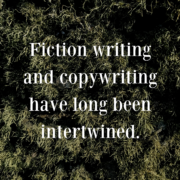5 Fiction-writing tips to apply to copywriting
Many copywriters reading this probably began their career because they love creative writing, no matter what form it takes. I know this was what led me to pursue my current position as a content marketing copywriter with Reedsy. Which I actually discovered through the short fiction contest we run every week!
Needless to say, fiction-writing and copywriting have long been intertwined in my mind. And many of the skills and strategies I’ve honed as a fiction writer have proven just as effective (if not more so) in the realm of copywriting. Today, I’d like to share five tips to help my fellow creatives channel their fiction-writing prowess into copywriting — and hopefully improve the overall quality of their work.
Table of Contents
1. Target a specific audience.
Any fiction writer worth their salt knows that to write for ‘the everyman’ is to write for no man. Having a specific audience in mind is what gives a story purpose and punch! This is why so many authors create proto-personas to address as they write; otherwise, it’s all too easy for prose to devolve into generalized dullness.
The same is true for copywriting — for your work to make an impact, it needs to cater to the right audience. Of course, as with fiction-writing (think contests where you don’t know who the judges are, or the early stages of writing a book). It’s not always immediately clear who that audience is. In this case, you’ll need to do some work to figure it out.
If your client doesn’t provide their target audience from the get-go, it’s fine to ask for clarification. However, be prepared to investigate yourself — a quick scan of their website, social media, and any copy they already have should give you a better idea of your target. If the client is just starting out and has little content to work from, think about similar businesses or products and who their target audiences are. Remember to be as specific as possible, and be wary of wishful thinking on the client’s part (as Scott McKelvey warns against in this post).
 2. Hook ‘em right away.
2. Hook ‘em right away.
Fiction writers understand the gravity of a good hook. Whether you’re entering a short story contest, submitting to a literary magazine, or trying to get a novel published, your opening lines had better be stellar. If they aren’t, the powers that be will lose interest like that (picture me snapping my fingers) and your literary aspirations will be dead in the water.
Naturally, this is crucial in copywriting as well. Wven more so, since you have to appeal to everyone who comes across your content. Not just a single agent or a small panel of judges. Knowing your target audience can definitely help you craft a useful hook. Especially if you want to start with a question or assumption about that audience (as I did at the beginning of this post). On the other hand, it’s also good to think about which kinds of hooks work universally!
In literature, the best hooks tend to be short, intriguing statements: “It was a dark and stormy night.” “Mrs Dalloway said she would buy the flowers herself.” “Call me Ishmael.” You can use this technique for copywriting too — but rather than setting a fictional scene, your statement should relate to real life. Try starting with a fact, statistic, or even a quote that’s relevant to the topic at hand. Almost everyone loves a bit of trivia, so when in doubt about your audience, this is the route to take.
3. Correctly calibrate the pacing.
Most copywriters recognize the importance of crafting a narrative, but what about the importance of moving that narrative along? In fiction, the rhythm of your story is paramount — the best story in the world can be spoiled by poor pacing. (Indeed, I’m sure we can all think of literary examples that many consider great, but which we’ve found agonizingly slow.)
You might not think of pacing as a major component of copywriting, especially because most copywritten pieces are relatively short. But when you have so few words to make your mark, pacing actually matters even more! In that constrained space, you need to get readers’ attention (the hook), explain why the topic at hand matters (the body), and wrap things up in a satisfying, memorable way (the resolution — we’ll get to that).
Say you’ve been given a 500 word limit and you spend 50 on the intro and 450 on the body. That level of detail is great for informing consumers and often for SEO. But now you have no words left for your conclusion. You’ll either have to leave it out or revise significantly before submitting the piece, which is always a pain. To avoid this fate, create a quick outline before writing anything, no matter how short it’s supposed to be. And if you feel yourself going overboard on detail, reel it back!
4. Transition effectively with fiction writing.
An occasional (and unfortunate) side effect of trying to pace one’s work more efficiently is the eschewal of good transitions. I know I just advocated for cutting excess detail, but transitions aren’t excessive; they’re essential. Without transitions in fiction, readers would experience constant confusion and frustration at every new scene, and most likely dismiss the work as unworthy of their time.
Similarly, without transitions in copywriting, the audience loses out on the smooth reading experience that tells them, “This is a high-quality product or service”. Basically, leaving out transitions looks sloppy and unprofessional, and can be incredibly off-putting to readers. Or even a deal-breaker in terms of convincing them to try what your copy promotes.
The good news is that most experienced copywriters are great at transitioning between thoughts, and even if you’re not, it’s an easy skill to acquire. For examples of good transitions, look at any article on this blog, including this one! Note how each sentence is connected to the sentences surrounding it. Especially through the usage of transition words like “however” and “because”, and adverbs like “clearly”, “similarly”, and “conversely” to compare ideas.
Remember that every sentence should only be a step away from the sentence before it, metaphorically speaking. If it’s more of a leap, start a new paragraph or even a new heading for your next point (just as I’m about to do).
5. Nail the ending.
Even if everything else about a story is fantastic, a lacklustre ending can undermine the whole text. And I say this as someone who reads dozens of short stories submitted per week to the aforementioned contest. I can think of nothing more disappointing as a reader than getting to the end of an otherwise brilliant piece of fiction and thinking, “Wait, that’s it?”
Again, you might not think that endings matter in copywriting, but they do. If the point of the main text is to get readers to pay attention, then the point of the ending is to get them to remember what they’ve read… which is arguably a much bigger deal. No pressure!
One tried-and-true, if slightly unoriginal, way to do this is by summarizing the points of your piece (in today’s world of short attention spans, reminders never hurt). A more compelling approach might be a personal appeal, e.g. “With this product, you can finally do X, Y, and Z”. Depending on the context, a call to action may be quite effective as well: “Get started today!” You can even go for a combination of all three, which is what I like to do.
Having reached the final paragraph of this post (congratulations!), you should now have a much stronger sense of which fiction-writing skills are best applied to copywriting. Targeting a specific audience, hooking them right away, pacing and transitioning effectively, and nailing the ending. With these tips in your arsenal, you’ll be exponentially more equipped to impress clients and sell their stuff like hotcakes. So get out there and start raking in the copywriting jobs!
Continue Reading: 5 copywriting tips to put a little pep in your step
 About the Author:
About the Author:
Savannah Cordova is a content marketer and copywriter with Reedsy, a marketplace that connects authors with the world’s best publishing professionals and resources on how to publish a book. In her spare time, Savannah enjoys reading contemporary fiction and writing short stories. Which is great practice for her work, of course. She lives in London and very much looks forward to writing in its many lovely coffee shops again.

 Fiction-copywritercollective
Fiction-copywritercollective 2. Hook ‘em right away.
2. Hook ‘em right away. About the Author:
About the Author: copywritingtips-copywritercollective
copywritingtips-copywritercollective  Clients-copywritercollective
Clients-copywritercollective